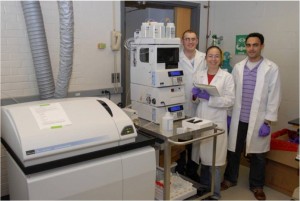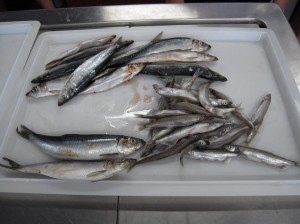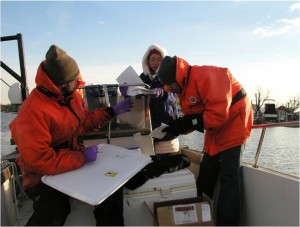| Study to Determine the Likelihood that the Reduction of Cr(VI) to Cr(III) will be a Permanent Process |
|
Biogeochemistry of Metals in Contaminated Sediments | Mercury in Aquatic Ecosystems |
Study to Determine Conditions Conducive to the Reduction of Cr(VI) to Cr(III) in Aquatic Environments and Sediment.
Chromium (Cr) is a common sedimentary contaminant, owing to its widespread use in a variety of industrial applications, including stainless steel production (corrosion inhibition), pigmentation, and tanning. In the environment, chromium exists in either the trivalent (+III) or hexavalent (+VI) oxidation states, with Cr(VI) considerably more mobile, bioavailable, and toxic than Cr(III).
Chromium ore mining and processing activities in the Baltimore, Maryland area began in the 1820s and continued through the mid-1980s, resulting in significant releases of Cr to the environment. Chromium-containing waste materials were disposed of at numerous locations throughout the Baltimore area, and are potential ongoing sources of both Cr(VI) and Cr(III) to the aquatic environment.
The CTFR recently completed a 3 year study which investigated factors such as sediment oxygenation, porewater pH, and organic matter content and quality that may impact the extent and rates of Cr(VI) reduction and Cr(III)oxidation. Of additional interest is the possible role of Mn(II)-oxidizing bacteria in generating highly reactive biogenic Mn(III,IV) (hydr)oxides capable of Cr(III) oxidation in sediments.
The primary objective of this research project was to identify the chemical conditions pertinent to Baltimore Harbor that govern the extent and rates of transformation of Cr(VI) to Cr(III). Specific sub-objectives of this work include (1) determine the significance of reduced iron and sulfur in the transformation of Cr(VI) to Cr(III), (2) determine the relative significance of microbial reduction of Cr(VI) to Cr(III), and (3) evaluate the rates of Cr(VI) reduction to Cr(III) by the chemical and microbial processes.
 A literature review on pertinent reduction processes for Cr was conducted to guide the subsequent chemical and biological characterizations. Sediment and pore water samples from the Baltimore Harbor were taken to our laboratory and spiked with Cr(VI) to determine reaction processes capable of reducing the Cr(VI) to Cr(III). The systems were characterized for reductants (e.g., Fe(II) and S(-II)) and microorganisms capable of Cr transformations. Several samples were studied to provide insight into the variability in the reduction processes across the Baltimore Harbor.
A literature review on pertinent reduction processes for Cr was conducted to guide the subsequent chemical and biological characterizations. Sediment and pore water samples from the Baltimore Harbor were taken to our laboratory and spiked with Cr(VI) to determine reaction processes capable of reducing the Cr(VI) to Cr(III). The systems were characterized for reductants (e.g., Fe(II) and S(-II)) and microorganisms capable of Cr transformations. Several samples were studied to provide insight into the variability in the reduction processes across the Baltimore Harbor.
CTFR utilized recently developed trace element speciation techniques such as high performance liquid chromatography inductively coupled plasma mass spectrometry (HPLC-ICP-MS) to quantify metal speciation in environmental media. The controlled laboratory experiments permitted a mass balance on the Cr species and were used to determine the extent and rates of Cr(VI) reduction to Cr(III). The laboratory conditions were designed to mimic the conditions in the Baltimore Harbor so that the results have direct relevance to the current environmental settings.
Study to Determine the Likelihood that the Reduction of Cr(VI) to Cr(III) will be a Permanent Process.
The objective of this research project was to determine the stability of Cr(III) in sediments. Specific sub-objectives of this work include (1) determine the significance of oxidants capable of transforming Cr(III) to Cr(VI) in sediments and the water column, such as manganese oxides and oxygen, (2) determine the rates of Cr(III) oxidation in sediments, even under conditions where it is thermodynamically unstable, and (3) determine the impact of introducing oxygen into anaerobic sediments on the stability of Cr(III).
Previous studies suggest that Cr(III) is stable in anaerobic sediments. Direct oxidation of Cr(III) to Cr(VI) by dissolved oxygen is very slow and does not appear to play a significant role in oxidizing Cr. Manganese (hydr)oxides are the only important naturally occurring oxidant of Cr(III). Elevated levels of manganese (hydr)oxides are not likely to be present in anaerobic sediments, especially under conditions that form acid volatile sulfides (AVS). Consequently, Cr(VI) reduction to Cr(III) dominates over the potential for Cr(III) oxidation. This research project will examine the extent to which sediments will remain a sink for Cr(III).
Sediment and pore water samples from the Baltimore Harbor were taken to our laboratory and spiked with Cr(VI) to facilitate reduction to Cr(III). Some of these sediments were incubated for long periods (up to two years) to monitor for presence of any detectable Cr(VI). An oxidation rate of Cr(III) can be calculated only if some conversion of Cr(III) to Cr(VI) can be observed. Another set of experiments determined the redox buffering capacity of the sediments by measuring a series of redox species (e.g., AVS, Fe(II), Mn(II), redox potential).
This information was used to determine the quantity of oxygen required to convert the system from an anaerobic sediment to an aerobic sediment. A final set of experiments examined the rates of Cr(III) oxidation in the presence of aerobic sediments and in the presence of manganese (hydr)oxides.
Experiments in our laboratory have quantified the extent and rates of oxidation/reduction reactions that control Cr speciation in sediments. Manganese(III,IV) (hydr)oxides are the principal naturally-occurring oxidants of Cr(III), and may oxidize Cr(III) in low-sulfide sediments, in aerobic microenvironments generated by benthic organisms, or during sediment resuspension events.
Work in our lab has demonstrated that rates of Cr(VI) reduction in Baltimore Harbor field sediments correlate with the presence of acid volatile sulfides (AVS, a measure of dissolved sulfide species plus minerals FeS and Fe3S4). Kinetics and stoichiometry of Cr(VI) reduction by synthetic pyrite have also been investigated, and data indicate that pyrite is capable of rapidly reducing Cr(VI). Our data suggest that measures of AVS and total reduced sulfur (AVS + pyrite) should be incorporated into exposure assessments for Cr in sediments.
Our findings, which appear in peer reviewed articles, have been used as the basis for revised regulations promulgated by US state and federal regulatory agencies. (See Selected Publications).
Biogeochemistry of Metals in Contaminated Sediments
Contamination of sediments with organic and metal pollutants is a widespread environmental problem that poses serious risk to aquatic ecosystems. CTFR members working in the area of metals biogeochemistry seek to understand the physical, chemical, and biological processes that govern the fate and transport of metals in the sediment-water system.
One of our interests is metal speciation, transport, and bioavailability within sulfidic sediments common to estuaries such as the Chesapeake Bay. Within the Baltimore Harbor, an industrialized subestuary of the Chesapeake Bay, contamination with numerous organic and metal pollutants has led to sediment toxicity at many locations throughout the Harbor. As in the case of contaminated aquatic ecosystems throughout the world, the causative agents have not been delineated.
Arsenic Speciation in Sediments
Speciation of arsenic in sediment porewater is of interest as arsenic mobility, bioavailability, and toxicity depend on the particular form of arsenic (As(III), As(V), organoarsenic species, and thioarsenic species). Our laboratory has applied HPLC-ICP-MS techniques to determine speciation at the low µg/L level in Baltimore Harbor sediment porewater. Results indicate that thioarsenic species are the dominant dissolved arsenic species at many locations in the Baltimore Harbor. Factors that affect thioarsenic species formation include pH, sulfide and polysulfide concentrations, and availability of reactive Fe (sulfide sequestration through formation of Fe-S minerals). Little is known about the toxicity of these thioarsenic species relative to other inorganic arsenic species (arsenite or arsenate) or organoarsenic species (monomethylarsenate, dimethylarsenate, etc.). Our results confirming the presence of thioarsenic species in the Baltimore Harbor demonstrate the need for additional research detailing the fate, transport, and toxicity of thioarsenic species in aquatic environments.
Mercury (Hg) is globally ubiquitous and environmentally persistent. Once human activities and natural processes release this metal from naturally-occurring reservoirs in the environment, mercury is generally transported with sediment. When sediment eventually settles out at the bottom of water bodies like lakes and estuaries, the mercury is deposited as well. In these sedimentary environments, anaerobic bacteria transform the inorganic Hg to methylmercury, primarily mono-methylmercury (MMHg).
Unfortunately, MMHg is toxic, and it is readily transferred out of the sediment and into the overlying water column, where it is taken up by aquatic organisms. MMHg bioacumulates, so animals higher up the food chain are exposed to greater concentrations in their diet. Eventually the Hg is transferred to top predators, like dolphins, and it can have toxic effects on the species. To better understand mercury bioaccumulation, CTFR has completed two research projects funded by the National Aquarium.
 The first project focused on the potential for dietary mercury exposure in captive bottlenose dolphins (Tursiops truncatus). Bottlenose dolphins that live at the National Aquarium in Baltimore are fed a diet of capelin and herring caught in fisheries in the North Atlantic. Herring and capelin have relatively low mercury concentrations compared with many other species of fish. However, dolphins can eat 20 or 30 pounds of fish a day, so even if their food contains only low levels of mercury, they could be affected by bioaccumulation and biomagnification as a result of continuous uptake of the toxic compound. We analyzed the total mercury, selenium, and methylmercury levels in diet fish to investigate the dolphins’ Hg exposure.
The first project focused on the potential for dietary mercury exposure in captive bottlenose dolphins (Tursiops truncatus). Bottlenose dolphins that live at the National Aquarium in Baltimore are fed a diet of capelin and herring caught in fisheries in the North Atlantic. Herring and capelin have relatively low mercury concentrations compared with many other species of fish. However, dolphins can eat 20 or 30 pounds of fish a day, so even if their food contains only low levels of mercury, they could be affected by bioaccumulation and biomagnification as a result of continuous uptake of the toxic compound. We analyzed the total mercury, selenium, and methylmercury levels in diet fish to investigate the dolphins’ Hg exposure.
Our findings demonstrated that the levels of Hg species in captive bottlenose dolphins at the National Aquarium were lower than levels found in a number of wild populations of these small cetaceans in areas throughout the world. Therefore, it was determined that dolphin diet fish currently being used did not result in unacceptable health risks due to Hg exposure. 
The second project takes an ecosystem approach to assess mercury bioaccumulation in resident bottlenose dolphins in Sarasota Bay, Florida. Although Hg is usually present in very low levels in the environment, high Hg levels have been measured in a variety of small cetaceans around the world. How these marine mammals come to have such high concentrations of mercury in their bodies is not clear: there are still many unresolved scientific questions about exposure pathways, bioaccumulation, and biomagnification.
In collaboration with the Sarasota Dolphin Research Program (Chicago Zoological Society / Mote Marine Laboratory), we have selected Sarasota Bay as a model ecosystem, and the native resident bottlenose dolphin as an example of a small cetacean. Previous research in Sarasota Bay has provided information about the ecology, population structure and dynamics, and the health of the resident bottlenose dolphins. Starting from such a robust data set minimized the uncertainties that arise from cetaceans’ unpredictable foraging habits, which can make it difficult to characterize Hg bioaccumulation in these species. Experimental work and mathematical modeling in the CTFR helped shed light on the fate and transport of Hg in Sarasota Bay, as well as, other ecosystems.
One of our colleagues is currently assessing levels of Hg species in the Mekong Delta and we anticipate expanding our research on Hg to other areas in S.E. Asia. We have published a number of peer reviewed articles (see Selected Publications) on our findings.


